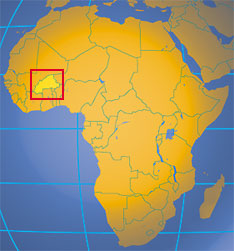 Burkina Faso (pronounced /bərˌkiːnə ˈfɑːsoʊ/ bər-KEE-nə FAH-soh; French: [byʁkina faso]) – also known by its short-form name Burkina – is a landlocked country in West Africa. It is surrounded by six countries: Mali to the north, Niger to the east, Benin to the southeast, Togo and Ghana to the south, and Côte d’Ivoire to the southwest.
Burkina Faso (pronounced /bərˌkiːnə ˈfɑːsoʊ/ bər-KEE-nə FAH-soh; French: [byʁkina faso]) – also known by its short-form name Burkina – is a landlocked country in West Africa. It is surrounded by six countries: Mali to the north, Niger to the east, Benin to the southeast, Togo and Ghana to the south, and Côte d’Ivoire to the southwest.
Its size is 274,000 km² with an estimated population of more than 15,757,000. Formerly called the Republic of Upper Volta, it was renamed on August 4, 1984, by President Thomas Sankara to mean “the land of upright people” in Mòoré and Dioula, the major native languages of the country. Figuratively, “Burkina” may be translated, “men of integrity,” from the Mòoré language, and “Faso” means “father’s house” in Dioula. The inhabitants of Burkina Faso are known as Burkinabè (pronounced /bərˈkiːnəbeɪ/ bər-KEE-nə-bay).
Burkina Faso was populated early, between 14,000 and 5000 BC, by hunter-gatherers in the northwestern part of the country. Settlements with farmers appeared between 3600 and 2600 BC. The central part of Burkina Faso included a number of Mossi kingdoms, which became a French protectorate in 1896. After gaining independence from France in 1960, the country underwent many governmental changes until arriving at its current form, a semi-presidential republic. The president is Blaise Compaoré.
Burkina Faso’s capital is Ouagadougou. It is a member of the African Union, Community of Sahel-Saharan States, La Francophonie, Organization of the Islamic Conference and Economic Community of West African States.
Burkina Faso is one of the poorest nations in the world, with few natural resources; the great majority of its workers engage in subsistence farming. Less than 10% of the country’s land area is cultivable without irrigation, and droughts have further limited agricultural production; however, several dams intended for irrigation and hydroelectricity, including the Ziga dam on the Nakambe River, which supplies the capital, were constructed in the 1990s. The principal cash crop is cotton; other agricultural commodities include peanuts, shea nuts, sesame, sorghum, millet, corn, and rice. Cattle, sheep, and goats are raised.
Literature in Burkina Faso is based on the oral tradition, which remains important. In 1934, during French occupation, Dim-Dolobsom Ouedraogo published his Maximes, pensées et devinettes mossi (Maximes, Thoughts and Riddles of the Mossi), a record of the oral history of theMossi people. The oral tradition continued to have an influence on Burkinabè writers in the post-independence Burkina Faso of the 1960s, such as Nazi Boni and Roger Nikiema.The 1960s saw a growth in the number of playwrights being published.Since the 1970s, literature has developed in Burkina Faso with many more writers being published.
The theatre of Burkina Faso combines traditional Burkinabè performance with the colonial influences and post-colonial efforts to educate rural people to produce a distinctive national theatre. Traditional ritual ceremonies of the many ethnic groups in Burkina Faso have long involved dancing with masks. Western-style theatre became common during colonial times, heavily influenced by French theatre. With independence came a new style of theatre inspired by forum theatre aimed at educating and entertaining Burkina Faso’s rural people.
The cinema of Burkina Faso is an important part of West African and African film industry. Burkina’s contribution to African cinema started with the establishment of the film festival FESPACO (Festival Panafrican du Cinéma et de la Télévison de Ouagadougou), which was launched as a film week in 1969. Many of the nation’s filmmakers are known internationally and have won international prizes. For many years the headquarters of the Federation of Panafrican Filmmakers (FEPACI) was in Ouagadougou, rescued in 1983 from a period of moribund inactivity by the enthusiastic support and funding of President Sankara (In 2006 the Secretariat of FEPACI moved to South Africa but the headquarters of the organization is still in Ouagaoudougou). Among the best known directors from Burkina Faso are: Gaston Kaboré, Idrissa Ouedraogo and Dani Kouyate,Burkina also produces popular television series such as Bobodjiouf. The internationally known filmmakers such as Ouedraogo, Kabore, Yameogo, and Kouyate make also popular television series.
The cuisine of Burkina Faso, typically of west African cuisine, is based around staple foods of sorghum, millet, rice, maize, peanuts, potatoes, beans, yamsand okra.The most common sources of protein are chicken, chicken eggs and fresh water fish. A typical Burkinabè beverage is Banji or Palm Wine, which is fermented palm sap, and Zoom-kom. Especially the town of Banfora is known for its good quality Banji, though you should be wary of the Banji sold byhawkers as it is often not very fresh and may contain added water.
August 30, 2009, Burkina Faso experienced the worst flood in the country’s recent history, leaving 150,000 people homeless, and more than 8 people dead. Burkina Faso people requested international aid to help the victims and rebuild the country. Japan, France, Ivory Coast and the European Union responded, while the Burkina American community requested that the president of the United States of America extend a helping hand to the victims of the flood.
Notes from Wikipedia and Answers.com









